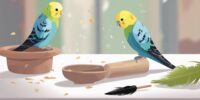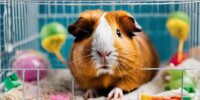How to Interpret the Body Language of Parrots Across Different Species
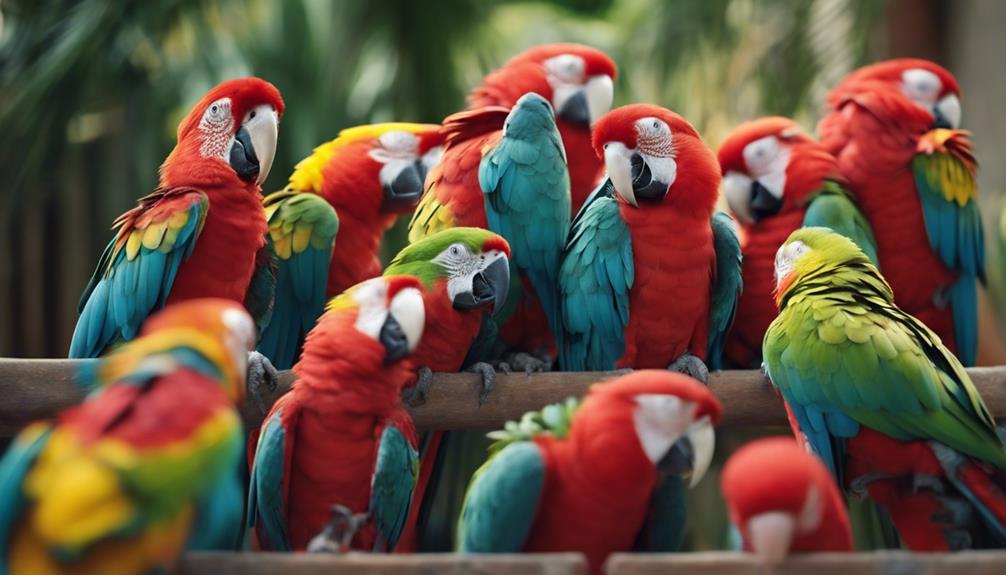
Parrots are known for their expressive body language, which can vary across different species. Each species of parrot has its own unique way of communicating through body movements, vocalizations, and facial expressions. By observing and understanding these cues, parrot owners can better interpret their bird's emotions and needs.
One common form of parrot body language is fluffing up their feathers, which can indicate that the bird is feeling content or relaxed. On the other hand, a parrot that is holding its feathers tightly against its body may be experiencing fear or aggression. Paying attention to these subtle cues can help owners provide a more enriching and supportive environment for their feathered friends.
Understanding Parrot Body Language Basics
When observing a parrot's body language, it's crucial to pay attention to subtle cues such as feather position and eye dilation. Understanding these signs can provide valuable insights into a parrot's emotional state and intentions.
Preening behavior is another essential aspect of parrot body language. Parrots meticulously groom themselves not only for hygiene but also as a form of communication. Preening behavior can indicate contentment, bonding, or even a desire for attention.
Additionally, vocalization cues play a significant role in deciphering parrot body language. Different vocalizations, from chirps to squawks, carry various meanings and can convey a wide range of emotions. By combining vocalization cues with body language signals, one can gain a more comprehensive understanding of what a parrot is trying to communicate.
Interpreting Vocalizations and Calls
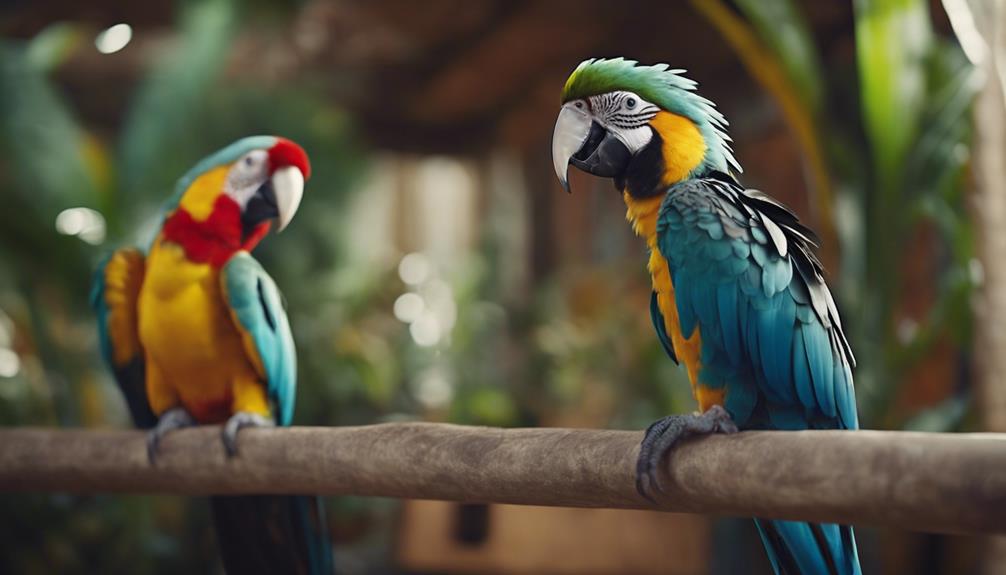
Interpreting a parrot's vocalizations and calls requires a keen understanding of the nuances in pitch, tone, and rhythm to accurately decipher the bird's emotional state and intentions. Parrots communicate through sound as a fundamental aspect of their social interactions, conveying a wide range of vocalization meanings and behavioral cues. Here are three key points to consider when interpreting a parrot's vocalizations:
- Pitch Variation: Pay attention to the range of pitches the parrot uses. Higher pitches can indicate excitement, alarm, or a desire for attention, while lower pitches may signal contentment or a need for comfort.
- Tone Quality: The quality of the sound produced is crucial. Harsh or shrill tones might suggest aggression or displeasure, whereas soft, melodic tones often indicate happiness or affection.
- Rhythmic Patterns: Observing the rhythm of the vocalizations can offer insights into the parrot's mood. Rapid, repetitive sounds could signify anxiety or a call for help, while slow, rhythmic patterns often accompany relaxed or playful behavior.
Decoding Feather Preening and Maintenance
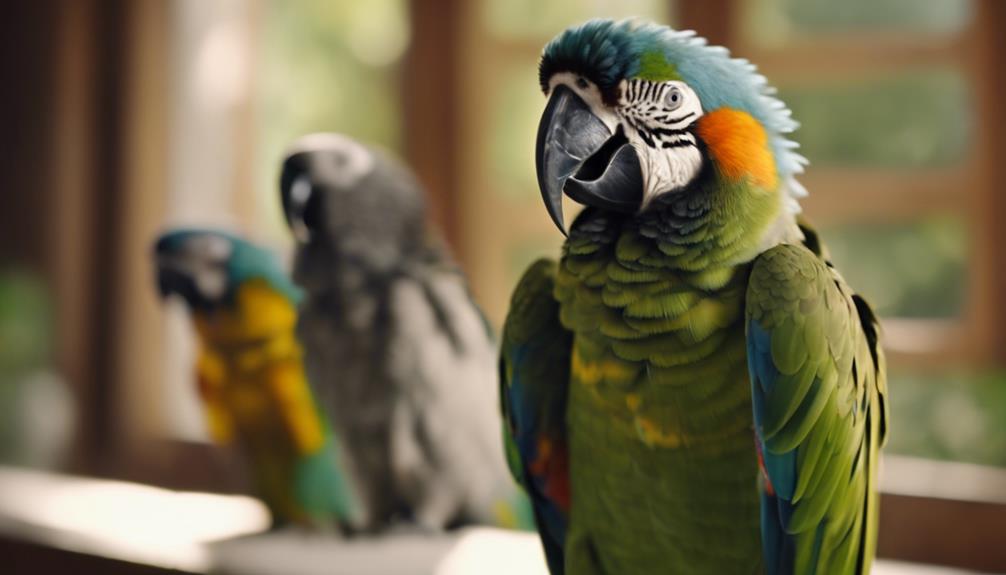
Parrots engage in feather preening as a form of grooming that serves various functions, including the removal of dirt, maintaining feather quality, and social bonding.
The meticulous process of preening not only ensures the bird's feathers are in optimal condition but also helps in the distribution of natural oils for waterproofing and insulation.
Observing a parrot's feather maintenance behaviors can provide valuable insights into their health, well-being, and social interactions within their environment.
Feather Preening Signals
Feather preening behavior in parrots serves as a vital aspect of their grooming routine, reflecting their hygiene and social interactions. When observing a parrot engaging in feather preening, one can glean valuable insights into the bird's well-being and relationships.
Here are three key points to consider:
- Social Bonding: Preening isn't only a way for parrots to maintain their feathers but also a social activity. Parrots often preen each other as a form of bonding and mutual care.
- Health Indicators: The quality and frequency of a parrot's preening can indicate its overall health. Regular and thorough preening is a sign of a healthy bird.
- Stress Relief: Preening can also serve as a stress-relief mechanism for parrots, helping them relax and feel more comfortable in their environment.
Importance of Grooming
Regular and thorough grooming of parrots through feather preening plays a crucial role in maintaining their health and social bonds. Feather preening isn't just a grooming behavior; it's a form of social interaction among parrots. Through preening, parrots not only keep their feathers clean but also strengthen their social connections with flock members or human companions. Additionally, feather preening serves as a way for parrots to show affection and care for one another.
Observing a parrot's grooming habits can also provide valuable health indicators. Changes in preening behavior, such as excessive preening or neglecting certain areas, may signal underlying health issues that require attention. Therefore, interpreting a parrot's grooming habits is essential for both their well-being and social interactions.
Analyzing Wing and Tail Movements
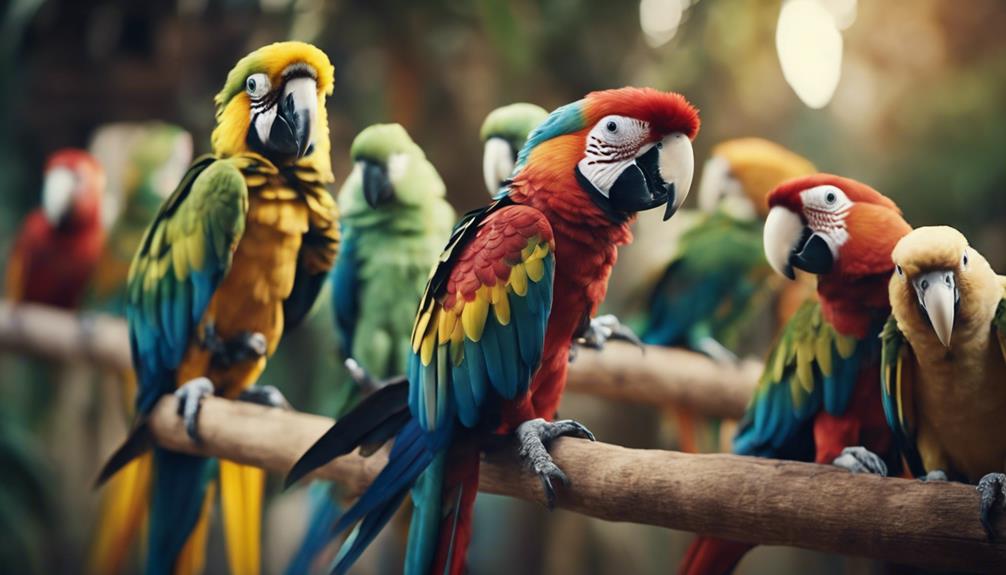
Parrots communicate through a variety of wing and tail movements.
Wing flapping signals can indicate excitement, playfulness, or a desire for attention.
Tail feather puffing is often a sign of relaxation or contentment in these intelligent birds.
Wing Flapping Signals
Often observed during moments of excitement or communication, wing flapping in parrots serves as a crucial form of non-verbal expression, conveying various messages through intricate movements.
Key Points:
- Wing flapping exercises, social interactions: Parrots engage in wing flapping as a way to exercise their flight muscles and to communicate their emotional state during social interactions.
- Wing flapping, territorial displays: In some species, wing flapping is also used as a territorial display to assert dominance or mark boundaries within their environment.
- Observation is key: Understanding the context and combining wing flapping signals with other body language cues can provide valuable insights into a parrot's current mood and intentions.
Tail Feather Puffing
Tail feather puffing in parrots can provide valuable insights into their emotional state and social interactions, complementing the signals conveyed through wing movements. Feather fluffing is a common behavior observed in parrots where they raise their tail feathers to appear larger or rounder. This action can serve as a communication signal, indicating excitement, curiosity, or even aggression.
Parrots may also puff their tail feathers during preening, a grooming behavior that strengthens social bonds and reinforces hierarchy within a group. Observing tail feather puffing alongside other body language cues can help caregivers and researchers better understand the nuances of parrot behavior and improve their interactions with these intelligent birds.
Reading Facial Expressions and Eye Contact
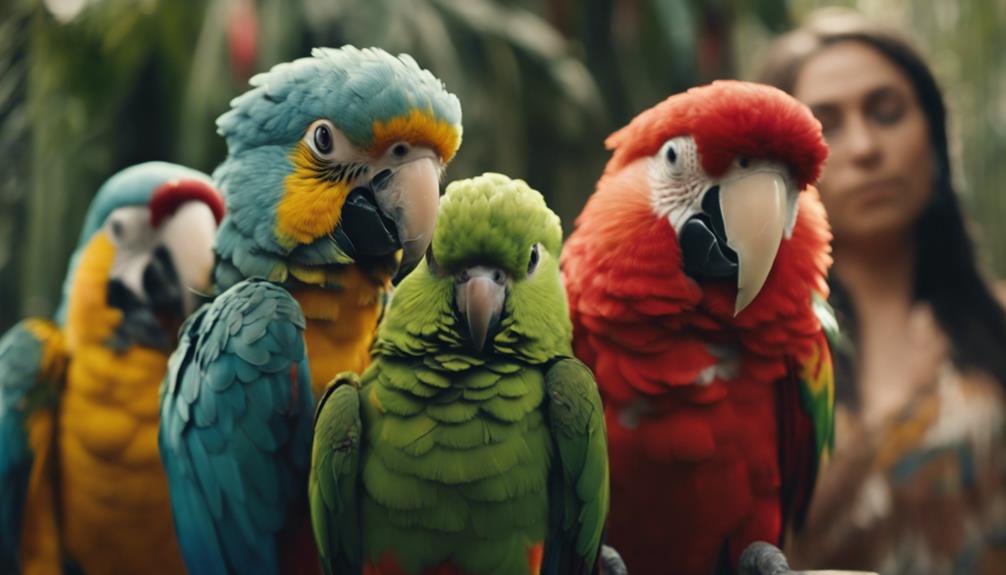
When observing parrot body language, understanding their facial expressions and eye contact is crucial for interpreting their communication signals. This nonverbal communication plays a significant role in their social interactions and can provide valuable insights into their feelings and intentions.
Key Points to Consider:
- Facial Expressions: Parrots exhibit a wide range of facial expressions, including narrowing of the eyes, puffing of the cheek feathers, and dilation of the pupils. These expressions can indicate emotions such as fear, aggression, curiosity, or contentment. It's essential to observe these subtle changes in their facial features to gauge their mood accurately.
- Eye Contact: Eye contact is a fundamental aspect of parrot communication. Direct eye contact can convey dominance or aggression, while averting their gaze may signal submission or fear. Understanding the significance of eye contact in different contexts is vital for interpreting the parrot's intentions and emotional state accurately.
- Consistency with Body Language: When analyzing facial expressions and eye contact, it's crucial to consider them in conjunction with the bird's overall body language. Consistency across these nonverbal cues can provide a more comprehensive understanding of the parrot's communication signals.
Observing Body Postures and Movements
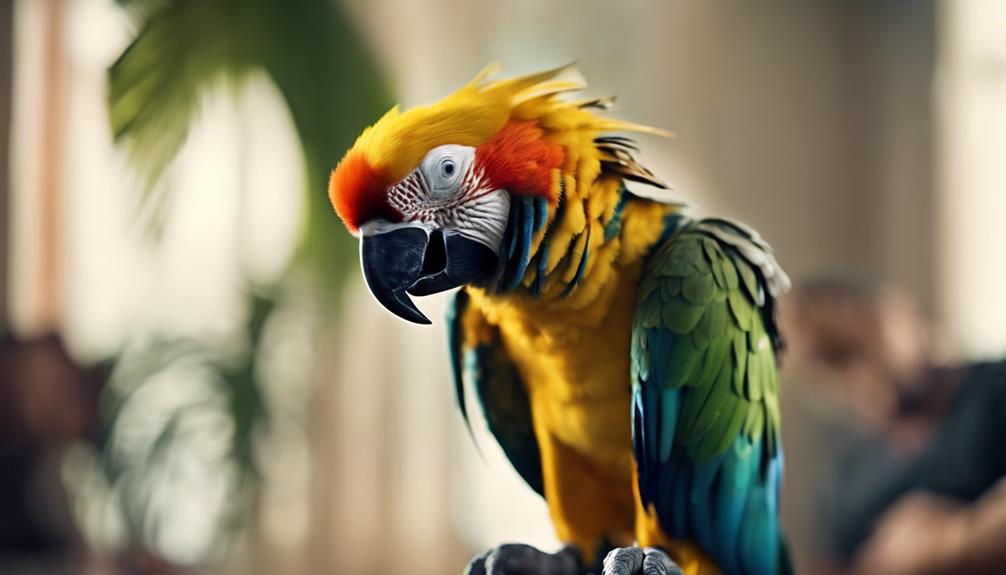
Interpreting parrot body language extends beyond facial expressions and eye contact to include a detailed analysis of their body postures and movements, which are integral in deciphering their communication signals. Observing a parrot's head bobbing can indicate excitement or a form of greeting, while beak grinding may suggest contentment or relaxation. Foot tapping is often a sign of nervousness or impatience, and wing stretching can signal a need for physical exercise or a desire to communicate dominance.
When a parrot stands tall with feathers sleeked back, it may be feeling confident or assertive. Conversely, a hunched posture with feathers puffed out can indicate fear or defensiveness. Paying attention to the angle of the body and the position of the tail feathers can also provide valuable insights into a parrot's emotional state and intentions.
Recognizing Signs of Stress and Aggression
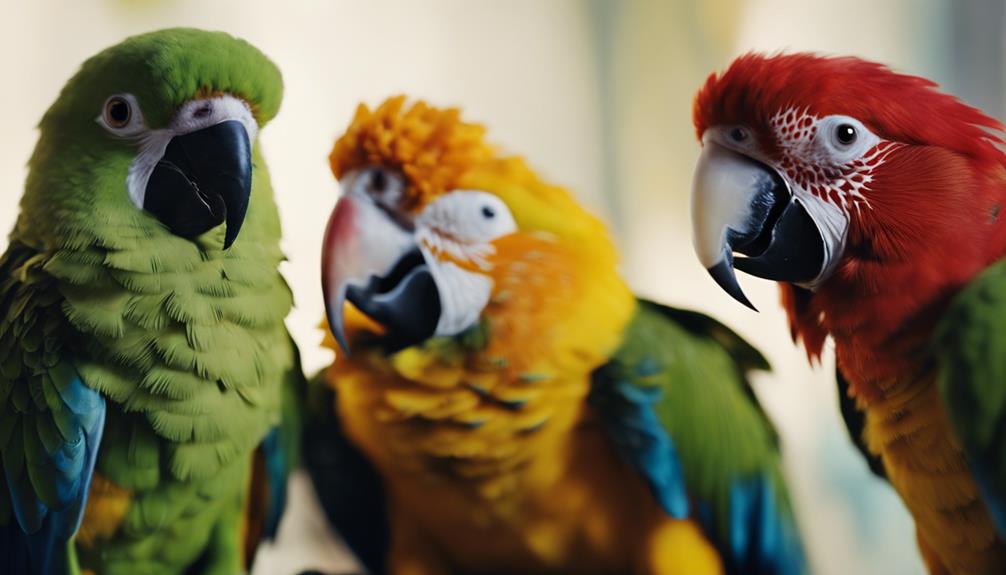
One critical aspect in understanding parrot behavior involves identifying subtle cues that indicate signs of stress and aggression. Parrots, like many animals, exhibit specific behaviors that signal their emotional state. Recognizing these signs can help prevent potential conflicts and ensure the well-being of these intelligent birds.
Key Points to Consider:
- Aggressive Behavior: Aggression in parrots can manifest through behaviors such as biting, lunging, or rapid head bobbing. These actions are clear indicators of distress or discomfort and shouldn't be ignored.
- Warning Signs: Watch out for warning signs like raised feathers, dilated pupils, and a tense body posture. These are communication cues that the parrot is feeling threatened and may lash out if the situation escalates.
- Communication Cues: Pay attention to vocalizations and body language changes. Squawking loudly, fluffing up feathers, or backing away can all be signs that the parrot is under stress and may become aggressive if not addressed promptly.
Frequently Asked Questions
How Can I Tell if a Parrot Is Feeling Lonely or Bored Based on Its Body Language?
To determine if a parrot feels lonely or bored, observe its behavior closely. Signs may include decreased vocalizations, withdrawal from social interactions, or excessive preening. Providing enrichment activities and considering environmental factors can help alleviate these emotions.
Are There Any Specific Body Language Cues That Indicate a Parrot Is Feeling Happy or Content?
When a parrot is happy or content, its body language becomes a vibrant symphony of joy. Vocal expressions convey cheerfulness, while social interactions bloom. Physical movements are lively, and feather displays are radiant, painting a picturesque scene of avian bliss.
Can Parrots From Different Species Communicate With Each Other Through Body Language?
Parrots from different species can communicate through body language. Behavioral similarities allow for inter-species communication in mixed flocks. Observing body language in diverse parrot groups reveals complex social dynamics and shared modes of expression.
What Are Some Common Misconceptions About Parrot Body Language That I Should Be Aware Of?
Common misconceptions about parrot body language include misunderstood signals due to behavioral differences. Communication challenges arise from cultural differences between parrot species, leading to misinterpretations. Understanding these nuances is crucial for accurate communication.
How Can I Differentiate Between Playful Behavior and Aggressive Behavior in Parrots Based on Their Body Language?
Deciphering parrot body language can be akin to unraveling a complex dance of gestures and postures. To differentiate between playful and aggressive behavior, focus on cues like relaxed feathers for playfulness and tense body language for aggression.


